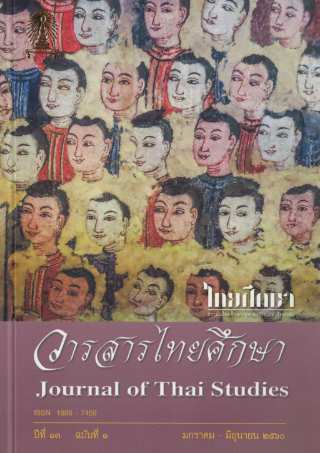The Relationship between Language and Representations of Isan People in National Newspapers: a Critical Discourse Analysis
Main Article Content
Abstract
This article aims at examining how Isan people are linguistically represented in national newspapers in Thai between the years 2004 to 2013 by employing the approach of Critical Discourse Analysis. The author focuses on two newspapers, namely Thairath and Dailynews. The data was collected from January 1, 2004 to December 31, 2013. Altogether 1,924 articles and news were collected. The analysis reveals that in the national newspapers several linguistic strategies are employed to represent Isan people. The six major strategies include: 1) lexical choice selection; 2) metaphors; 3) presupposition; 4) the use of passive voice structure; 5) the use of intertextuality; and 6) the use of rhetorical questions. All these linguistic strategies represent of Isan people in three different aspects: 1) Personality and traits: Isan people are proud of themselves and their region. They are patient, group-oriented and generous; 2) Economic and social aspect: Isan people are poorly educated and lack of opportunity. Isan people are labor force. They are victimized by other groups of people; 3) Political aspect: Isan people are a major political stronghold that plays an influential role in Thai politics. However, they often become political victims. The representations of Isan people are prominently related to social context. They are somewhat biased which reflects social inequality.
Downloads
Article Details

This work is licensed under a Creative Commons Attribution-NonCommercial-NoDerivatives 4.0 International License.
Journal of Thai studies is licensed under a Creative Commons Attribution-Noncommercial-NoDerivatives4.0 Intenational (CC BY-NC-ND 4.0) licence, unless otherwise stated. Plese read our Policies page for more information on Open Access, copyright and permissions.
References
ภาษาไทย
กฤษดาวรรณ หงศ์ลดารมภ์. (๒๕๔๓). ความเป็น “พวกเรา”และ“พวกเขา” ในสังคมไทย: การรายงานข่าวเกี่ยวกับชาวเขาในวาทกรรมหนังสือพิมพ์ไทย. วารสาร
มหาวิทยาลัยศิลปากร. ๑๙-๒๐๐๓: น. ๑๑-๑๗.
กฤษดาวรรณ หงศ์ลดารมภ์. (๒๕๔๓). ปริจเฉทเกี่ยวกับชนกลุ่มน้อยในประเทศไทย: การศึกษาความสัมพันธ์ระหว่างภาษากับอุดมการณ์. รายงานผลการวิจัยจุฬาลงกรณ์มหาวิทยาลัย,
กฤษดาวรรณ หงศ์ลดารมภ์ และจันทิมา เอียมานนท์. (๒๕๔๙). มองสังคมผ่านวาทกรรม. กรุงเทพฯ: สำนักพิมพ์จุฬาลงกรณ์มหาวิทยาลัย.
กาญจนา เจริญเกียรติบวร. (๒๕๔๓). ความสัมพันธ์ระหว่างภาษากับมุมองในข่าววัดพระธรรมกายที่เสนอในหนังสือพิมพ์ไทย วิทยานิพนธ์มหาบัณฑิต ภาควิชาภาษาศาสตร์ คณะอักษรศาสตร์ จุฬาลงกรณ์มหาวิทยาลัย.
เขียน ธีระวิทย์ และสุณัย ผาสุข. (๒๕๓๘). กัมพูชา : ประวัติศาสตร์ สังคม เศรษฐกิจ ความมั่นคง การเมืองและการต่างประเทศ. กรุงเทพฯ: สำนักงานกองทุนสนับสนุนการวิจัย. สถาบันเอเชียศึกษา จุฬาลงกรณ์มหาวิทยาลัย.
จารุภา พานิชภักดิ์. (๒๕๕๒). การสร้างภาพตัวแทนผู้หญิงของกลุ่มผู้ผลิตละครโทรทัศน์: การต่อสู้เรื่องความหมาย. สำนักงานบัณฑิตศึกษา มหาวิทยาลัยธรรมศาสตร์.
ชนกพร พัวพัฒนกุล. (๒๕๔๘). อุดมทรรศน์เกี่ยวกับ “เขมร” ในปริจเฉทหนังสือพิมพ์ไทย: กรณีเหตุจลาจลเผาสถานทูตไทยในกัมพูชา พ.ศ.๒๕๔๕. วิทยานิพนธ์มหาบัณฑิต ภาควิชาภาษาไทย คณะอักษรศาสตร์ จุฬาลงกรณ์มหาวิทยาลัย,
ชญานุช วีรสาร. (๒๕๔๓). เนื้อหาด้านบันเทิงในหนังสือพิมพ์รายวัน. วิทยานิพนธ์ปริญญามหาบัณฑิต ภาควิชาสารสนเทศ คณะนิเทศศาสตร์ จุฬาลงกรณ์มหาวิทยาลัย.
ชาร์ลส์ เอฟ คายส์. รัตนา โตสกุล แปล. (๒๕๕๖). อีสานนิยม : ท้องถิ่นในสยามประเทศไทย Isan: Regionalism in Northeastern Thailand. พิมพ์ครั้งที่ ๕. กรุงเทพฯ: มูลนิธิโครงการตำราสังคมศาสตร์และมนุษยศาสตร์.
ไชยรัตน์ เจริญสินโอฬาร. (๒๕๔๓). วาทกรรมการพัฒนา: อำนาจ ความรู้ ความจริง เอกลักษณ์และความเป็นอื่น. พิมพ์ครั้งที่ ๒ .กรุงเทพฯ : ศูนย์วิจัยผลิตตำรา มหาวิทยาลัยเกริก.
ไชยรัตน์ เจริญสินโอฬาร. (๒๕๕๖). ภาษากับการเมือง /ความเป็นการเมือง. พิมพ์ครั้งที่ ๒. กรุงเทพ: โครงการตำราและสิ่งพิมพ์ คณะรัฐศาสตร์ มหาวิทยาลัยธรรมศาสตร์.
ณรงค์ เพ็ชรประเสริฐ. (๒๕๔๖). บทสังเคราะห์ภาพรวมการพัฒนาระบบสวัสดิการสำหรับคนจนและคนด้อยโอกาสในสังคมไทย. กรุงเทพฯ: เอดิสันเพรส โปรดักส์.
ณัฐพร พานโพธิ์ทอง. (๒๕๕๖). วาทกรรมวิเคราะห์เชิงวิพากษ์ตามแนวภาษาศาสตร์ : แนวคิดและการนำมาศึกษาวาทกรรมในภาษาไทย. กรุงเทพฯ: โครงการเผยแพร่ผลงานวิชาการ คณะอักษรศาสตร์จุฬาลงกรณ์มหาวิทยาลัย.
ธีรยุทธ บุญมี. (๒๕๕๑). มิเชล ฟูโกต์. กรุงเทพฯ: วิภาษา.
ธีระยุทธ สุริยะ. (๒๕๕๔). ความสัมพันธ์ระหว่างภาษากับภาพตัวแทนนักโทษประหารและการประหารชีวิตในหนังสือพิมพ์รายวัน. วิทยานิพนธ์มหาบัณฑิต ภาควิชาภาษาไทย คณะอักษรศาสตร์ จุฬาลงกรณ์มหาวิทยาลัย.
นพฤทธิ์ ด้วงวิเศษ. (๒๕๕๕). ๒๕๕๓ อ่านข่าว อ่านสังคมไทย. กรุงเทพฯ: ศูนย์มานุษยวิทยาสิรินธร.
นิธิ เอียวศรีวงศ์. (๒๕๕๓). อ่านการเมืองไทย. กรุงเทพฯ : openbook.
นิติพงศ์ พิเชษฐพันธุ์. (๒๕๕๓). วาทกรรมเหตุการณ์พิพาทเขาพระวิหาร พ.ศ. ๒๕๕๑ จากหนังสือพิมพ์รายวันภาษาไทย : การศึกษาความสัมพันธ์ระหว่างภาษาและ
อุดมการณ์ วิทยานิพนธ์มหาบัณฑิต ภาควิชาภาษาไทย คณะอักษรศาสตร์ จุฬาลงกรณ์มหาวิทยาลัย.
บัวพันธ์ พรหมพักพิง และคณะ. (๒๕๔๘). การแต่งงานข้ามวัฒนธรรมของผู้หญิงในชนบทอีสาน. รายงานผลการวิจัยสำนักงานคณะกรรมการวัฒนธรรมแห่งชาติ กระทรวงวัฒนธรรม.
เบญจวรรณ อุปัชฌาย์. (๒๕๔๓). การสะท้อนภาพกลุ่มชาติพันธุ์ต่างๆ ในสังคมไทยของหนังสือพิมพ์รายวัน. วิทยานิพนธ์มหาบัณฑิต ภาควิชาวารสารสนเทศ คณะนิเทศศาสตร์ จุฬาลงกรณ์มหาวิทยาลัย.
บุญทิวา พ่วงกลัด. (๒๕๕๔). วาทกรรม”บุญนิยม” : กรณีศึกษาชุมชนราชธานีอโศก จังหวัดอุบลราชธานี. วารสารมนุษยศาสตร์และสังคมศาสตร์ ๒๘ (๒) พฤษภาคม–สิงหาคม.
ปรีชา พิณทอง. (๒๕๓๔). “คำชมเชย”, ใน ไพบูลย์ แพงเงิน.กลอนลำ: ภูมิปัญญาของอีสาน. กรุงเทพฯ: สำนักพิมพ์โอเดียนสโตร์.
พรรณธร ครุฑเนตร. (๒๕๕๗). กลวิธีทางภาษาที่ใช้ยุติการสนทนาที่มีความขัดแย้งในภาษาไทย. วิทยานิพนธ์ดุษฎีบัณฑิต ภาควิชาภาษาไทย คณะอักษรศาสตร์ จุฬาลงกรณ์มหาวิทยาลัย.
พัชราภรณ์ ครุฑเมือง. (๒๕๕๒). การดำรงอยู่ของหนังสือพิมพ์ท้องถิ่นเอกราชท่ามกลางกระแสการเปลี่ยนแปลงของสังคม. วิทยานิพนธ์มหาบัณฑิต ภาควิชาวารสารสนเทศ คณะนิเทศศาสตร์ จุฬาลงกรณ์มหาวิทยาลัย.
พิณรัตน์ อัครรัตนกุล. (๒๕๔๘). “ลาว”และ“ไท” ความเข้าใจที่ไม่ตรงกัน” ในมองสังคมผ่านวาทกรรม. กรุงเทพฯ : สำนักพิมพ์จุฬาลงกรณ์มหาวิทยาลัย.
มาลี บุญศิริพันธ์. (๒๕๓๑). หลักการทำหนังสือพิมพ์เบื้องต้น. กรุงเทพฯ: คณะวารสารศาสตร์และสื่อสารมวลชน มหาวิทยาลัยธรรมศาสตร์.
เรืองวิทย์ เกษสุวรรณ. (๒๕๕๓). หลักรัฐศาสตร์. พิมพ์ครั้งที่ ๔. กรุงเทพฯ: ซีเอ็ดยูเคชั่น.
แวง พลังธรรม. (๒๕๔๕). อีสานคดีชุด ลูกทุ่งอีสาน ประวัติศาสตร์อีสานตำนานเพลงลูกทุ่ง. กรุงเทพฯ: เรือนปัญญา.
วุฒินันท์ แก้วจันทร์เกตุ. (๒๕๕๓). อุดมการณ์ความเป็นชายในวาทกรรมในโฆษณาสินค้าและบริการสำหรับผู้ชายในนิตยสารผู้ชาย. วิทยานิพนธ์มหาบัณฑิต ภาควิชาภาษาไทย คณะอักษรศาสตร์ จุฬาลงกรณ์มหาวิทยาลัย.
ศิริพร ภักดีผาสุข. (๒๕๕๓). วาทกรรม “ความเป็นผู้หญิง”ในนิตยสารสุขภาพและความงามภาษาไทย”. รายงานการวิจัยภาควิชาภาษาไทย คณะอักษรศาสตร์ จุฬาลงกรณ์มหาวิทยาลัย.
สมพงษ์ ใหม่วิจิตร. (๒๕๓๔). ค่านิยมในสังคมไทย: อุปสรรคต่อการปกครองในระบอบประชาธิปไตย. กรุงเทพฯ: วิทยาลัยป้องกันราชอาณาจักร.
เสนาะ เจริญพร. (๒๕๔๘). ผู้หญิงกับสังคมในวรรณกรรมไทยยุคฟองสบู่. กรุงเทพฯ: มติชน.
อภิศักดิ์ โสมอินทร์. (๒๕๓๗). โลกทัศน์อีสาน. พิมพ์ครั้งที่ ๒. มหาสารคาม: อภิชาตการพิมพ์.
ภาษาอังกฤษ
Duncan Mccrago and Krisadawan Hongladarom. (2004). “Contesting Isan-ness: Discourses of Politics and Identity in Northeast Thailand”. Asian Ethnicity Vol. 5(2): p. 219-234.
Fowler, R. (1991). Language in the News: Discourse and Ideology in the Press. London : Routledge.
Gee, James Paul. (2005). An Introduction to Discourse Analysis: Theory and Method; 2nd edition. New York: Routledge.
Geraint O.Edwards. (2012). “A comparative discourse analysis of the construction of “In-groups” in the 2005 and manifestos of the British National Party”. Discourse and Society Vol. 23 (3): p. 245-258.
Hall, S. (1997). Representation: Cultural Representations and Signifying Practice. London: SAGE.
John Flowerdew And David C.S. Li, Sarah Tran. (2002). Discriminatory news discourse : some Hong Kong data”. Discourse and Society Vol. 13 (3): p. 319-345.
John Oddo. (2011). “War legitimation discourse : Representing “Us” and “Them” in four US presidential addresses”. Discourse and Society Vol. 22 (3): p. 287-314.
Karmen Erjavec. (2001). “Media representation of the discrimination against the Roma in Eastern Europe : the case of Slovenia”. Discourse and Society Vol. 12 (6): p. 699-727.
Natthaporn Panpothong. (2007). “Discourse of Plastic Beauty: A Critical Analysis of Cosmetic Surgery Ads in Thai” paper presented at the International Symposium on Discourse, Communication and Mordernity, Chulalongkorn University.
Norman Fairclough. (1992). “Intertextuality”. Discourse and Social Change p. 101-136. Cambridge: Polity Press.
Norman Fairclough. (1995). “Section A :Language, ideology and power” Critical discourse analysis: the critical study of language. p. 1-81. London and New York: Longman.
Norman Fairclough. (1995). Media Discourse. London: Edward Arnold.
Peter Teo. (2000). “Racism in the News: A Critical Discourse Analysis of News Reporting in Two Australian Newspapers”. Discourse and Society Vol. 11 (1): p. 7-49.
Phillips, Louise, and Marinne Jorgensen. (2002). “Critical Discourse Analysis”. Discourse Analysis as Theory and Method, p. 60-95. London: Sage.
Pravit Rojanaphruk. (2010). “Rural Thais are No Longer Ignorant: Klausner”. The Nation on Sunday. 22 August.
Teun A.van Dijk. (2008). “Introduction: Discourse and Domination”. Discourse and Power p. 1-27. London: Sage.
Teun A.van Dijk. (2008). “Discourse and Manipulation” Discourse and Power. p. 211-236 London: Sage,
Teun A.van Dijk. (2008). “Discourse and Racism”. Discourse and Power p. 102-119 London: Sage.
Teun A.van Dijk. (2003). Critical Discourse Analysis. The Handbook of Discourse Analysis, p. 352-371. Malden, MASS and Oxford: Blackwell.
Yasmin Jiwani and John E.Richardson. (2011). “Discourse, Ethnicity and racism”. Discourse Studies : A Multidisciplinary Introduction. p. 241-260 London: Sage.
Smalley, William A. (1994). Linguistic Diversity and National Unity: Language Ecology in Thailand. Chicago and London: The University of Chicago Press.


